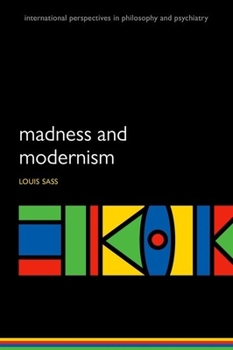Madness and Modernism: Insanity in the Light of Modern Art, Literature, and Thought (Revised Edition)
Select Format
Select Condition 
Book Overview
The similarities between madness and modernism are striking: defiance of convention, nihilism, extreme relativism, distortions of time, strange transformations of self, and much more. In this revised edition of a now classic work, Louis Sass, a clinical psychologist, offers a radically new vision of schizophrenia, comparing it with the works of such artists and writers as Kafka, Beckett, and Duchamp, and considering the ideas of philosophers...
Format:Paperback
Language:English
ISBN:0198779291
ISBN13:9780198779292
Release Date:October 2017
Publisher:Oxford University Press
Length:560 Pages
Weight:1.95 lbs.
Dimensions:1.3" x 6.1" x 9.4"
Customer Reviews
5 ratings
Contemporary classic
Published by Thriftbooks.com User , 18 years ago
This is one of my favorite books. As a work on psychological styles and the nature of rationality, I rank it right up with The Greeks and the Irrational, by E.R. Dodds. The basic argument is that madness is not irrationality, but extreme and excessive rationality, and that the totalizing reasoning of madness shows parallels to the totalizing reasoning of philosophical, artistic, and literary modernism. This is an intriguing view in its own right, and it is a valuable response to the romanticization of madness by those such as Norman O. Brown, who declared that "schizophrenia is the dissolution of the false boundaries of self." I do have some reservations about this fascinating argument. First, I don't think Sass ever makes clear the nature of the connection between madness and modernism. Does he see the former as caused by the latter? Are both manifestations of the organization of an industrial society? Second, Sass doesn't seem to recognize that he is actually working within a well-established intellectual tradition. The psychological and aesthetic literature on decadence in the late nineteenth century, as exemplified by Max Nordau's Degeneration, saw both madness and avant-garde artistic expression as products of hypertrophy of the intellect. Third, there may be important differences between the deterministic world of madness and that of modernism. Specifically, the rationality of modernity can be seen as connecting causes and effects on a single surface of reality that neither reflects nor penetrates any other dimension. Madness, on the other hand, seems to work within a rationality of depth, giving thoughts and occurrences a metaphysical resonance.
Best book I've seen for explaining schizoid personalities
Published by Thriftbooks.com User , 21 years ago
While growing up I had several friends, and acquaintances, who were diagnosed as having schizoid personalities. I was curious, so I read several books on the subject and this is the only one that actually seemed to line it's theories up with what I knew from personal experience. Namely, that these were people who were hyperconscious. He did well in explaining how this could create distortions in viewpoint rather than enhancements. A few of my friends were even fans of the artists and philosophers referenced in the book as examples. His references to Foucault, his theory of the panopticon, and the empirical and transcendental doublet were also very insightful in explaining his theory.
Fascinating and Informative
Published by Thriftbooks.com User , 24 years ago
The erudite Louis Sass provides insight not only into the experience of schizophrenia but also its expression in modern art. Although his thesis is that schizophrenia is not a regression in mentality but a hypertrophy of consciousness, he never allows the reader to forget that it is still a debilitating illness. His book introduced me to and helped me understand a number of artists and writers, especially Giorgio DiChirico. Not an easy book, but readable and rewarding.
links between creativity and madness
Published by Thriftbooks.com User , 27 years ago
As an artist and a schizophrenic, I have searched for books comparing the two; this is the first I've found, and it's a good one, as well. The need to create, the ability to see and understand what others can't or don't, is clearly explained. The only reason I give it a 9 instead of a 10 is that it could cover more photography, samples of artist's writings and include areas such as found and insane poetry and naive art.
Fascinating similarities between modernism and schizophrenia
Published by Thriftbooks.com User , 27 years ago
Louis Sass has written a fascinating comparison of modernism and schizophrenia and related disorders -- I couldn't put this book down. Sass' knowledge of modern art and literature, coupled with his experience as a clinical psychologist and professor at Rutgers, makes this book. It's extremely well-written -- the language is complex, but by no means stilted and academic for the sake of being academic. Sass' words will catch you and draw you through fascinating discussions about identity, language, visual representation, and much more. He presents balanced observations and makes appropriate connections -- he doesn't romanticize schizophrenia. One story he relays expresses this perfectly (pardon my paraphrasing): James Joyce discussed the creative similarities between him and his daughter, a schizophrenic, with Carl Jung. Jung described the difference between Joyce's creativity and his daughter's seeming creativity by saying that the difference was that Joyce was diving down into the depths while his daughter was falling. This is a perfect analogy to put Sass' book into perspective. If you have any interest in issues of identity, psychology, and modern culture, you will want to read this book.





